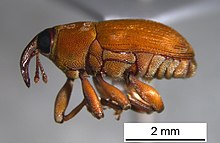Zyzzyva
| Zyzzyva | |
|---|---|

| |
| Scientific classification | |
| Domain: | Eukaryota |
| Kingdom: | Animalia |
| Phylum: | Arthropoda |
| Class: | Insecta |
| Order: | Coleoptera |
| Suborder: | Polyphaga |
| Infraorder: | Cucujiformia |
| Family: | Curculionidae |
| Subfamily: | Baridinae |
| Tribe: | Madarini |
| Genus: | Zyzzyva Casey, 1922 |
| Type species | |
| Zyzzyva ochreotecta Casey, 1922 | |
| Species | |
| |
Zyzzyva /ˈzɪzɪvə/ is a genus of South American weevils, often found on or near palm trees.[1] It was first described in 1922 by Thomas Lincoln Casey Jr., based on specimens obtained in Brazil by Herbert Huntingdon Smith.[2]: 2, 369
Casey describes Zyzzyva ochreotecta in his book Memoirs on the Coleoptera, Volume 10:[2]: 369–370
Rather broadly oblong-oval, convex, densely clothed with scales, ochreous and very uniform above, completely concealing the sculpture; beak (♂) scarcely longer than the prothorax, thick, distinctly arcuate, compressed basally, finely, closely punctate, longitudinally furrowed and carinate above; antennae obscure rufous; prothorax two-fifths wider than long, the sides parallel and nearly straight in basal two-fifths, thence oblique and nearly straight to the apex, which is truncate and much less than half as wide as the base; parallel scales dense and directed longitudinally in great part; elytra a third longer than wide, a fifth or sixth wider than the prothorax and nearly two and one-half times as long, the sides parallel, broadly, circularly rounded in apical third, the sutural angle not reëntrant; pygidium closely but not densely clothed with slender and suberect pale squamules; under surface without sexual mark, the first ventral suture fine but very distinct throughout, the others coarse, the fourth not reflexed at the sides. Length 4.3 mm.; width 2.0 mm. Brazil (Santarem). One specimen.
Etymology
Zyzzyva has achieved notoriety for being the last word in several English-language dictionaries.[3][4][5] Casey is commonly credited with naming the genus, although the etymology of the word is unclear.[5][3][1] One theory is that the word was inspired by Zyzza, a former genus of leafhoppers.[3] An entomologist at New York's Museum of Natural History speculated that Casey made up the word as a joke, "to have the last word."[5]
Species
There are three accepted species within this genus.[6]
- Zyzzyva ochreotecta Casey, 1922
- Zyzzyva rufula Hustache, 1951
- Zyzzyva squamosa (C.H.Boheman, 1844)
See also
- Aaaaba
- Aaadonta
- Zyzzogeton, a leafhopper, another "last entry"
- Zyzzyxdonta alata
- Zyzzyzus
- Zzyzx (disambiguation)
References
- ^ a b Andrews, Travis M. (2017-06-27). "The Oxford English Dictionary has a new last word. Bet you can't pronounce it". Washington Post. Archived from the original on 2017-06-27. Retrieved 2021-06-27.
- ^ a b Casey, Thomas L. (1922). Memoirs on the Coleoptera. Vol. 10. Lancaster, PA: New Era. doi:10.5962/bhl.title.15993. BHL page 15912352.
- ^ a b c Martin, Katherine Connor (2017-06-16). "New words notes June 2017". Oxford English Dictionary. Oxford University. Archived from the original on 2021-06-27. Retrieved 2021-06-27.
- ^ "What is the absolute last word in any dictionary?". Dictionary.com. Archived from the original on 2014-08-23. Retrieved 2021-06-27.
- ^ a b c Storer, Doug (1981-04-24). "He Looks Like A Pig, A Bear, Kangaroo..." Amazing But True. The Evening Independent. St. Petersburg, FL. p. 6-B. Retrieved 2021-06-27.
- ^ "Zyzzyva T.L.Casey, 1922". www.gbif.org. Retrieved 2024-11-23.
